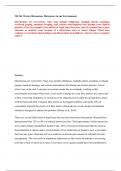Resume
Samenvatting - Project Management Essentials
- Établissement
- Arteveldehogeschool (Artevelde)
samenvatting Project Management Essentials. Dit vak wordt gegeven op ArteveldeHogeschool in het eerste jaar Event en Project Management, of als keuzevak in het tweede en derde jaar.
[Montrer plus]












